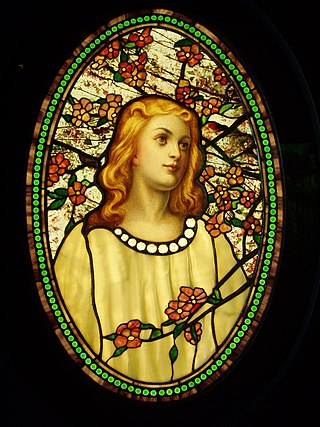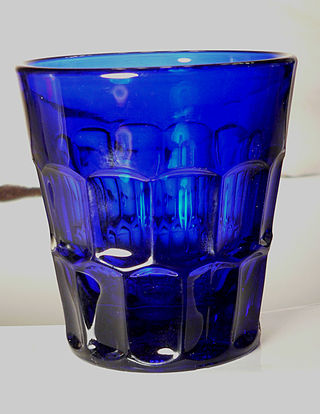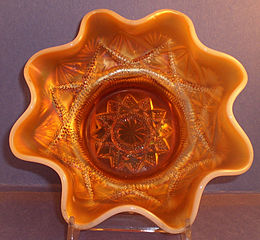Schnapps or schnaps is a type of alcoholic beverage that may take several forms, including distilled fruit brandies, herbal liqueurs, infusions, and "flavored liqueurs" made by adding fruit syrups, spices, or artificial flavorings to neutral grain spirits.

Glassblowing is a glassforming technique that involves inflating molten glass into a bubble with the aid of a blowpipe. A person who blows glass is called a glassblower, glassmith, or gaffer. A lampworker manipulates glass with the use of a torch on a smaller scale, such as in producing precision laboratory glassware out of borosilicate glass.

Fire-King is an Anchor Hocking brand of glassware similar to Pyrex. It was formerly made of low expansion borosilicate glass and ideal for oven use. Currently it is made of tempered soda-lime-silicate glass in the US and borosilicate in Japan

Jolly Rancher is an American brand of sweet hard candy, gummies, jelly beans, lollipops, sour bites, and a line of soda put out by Elizabeth Beverage Company in 2004. Originally created in Colorado in the 1950s, the Jolly Rancher brand has been owned by The Hershey Company since 1996.

A rhinestone, paste or diamante is a diamond simulant originally made from rock crystal but since the 19th century from crystal glass or polymers such as acrylic.

Burmese glass is a type of opaque colored art glass, shading from yellow, blue or green to pink. It is found in either the rare original "shiny" finish or the more common "satin" finish. It is used for table glass and small, ornamental vases and dressing table articles.

Carnival glass is moulded or pressed glass to which an iridescent surface shimmer has been applied. It has previously been referred to as aurora glass, dope glass, rainbow glass, taffeta glass, and disparagingly as 'poor man's Tiffany'. The name Carnival glass was adopted by collectors in the 1950s as items of it were sometimes given as prizes at carnivals, fetes, and fairgrounds. However, evidence suggests that the vast majority of it was purchased by households to brighten homes at a time when only the well-off could afford bright electric lighting, as its finish catches the light even in dark corners. From the beginning of the 20th century, carnival glass was mass-produced around the world, but largely and initially in the U.S. It reached the height of its popularity in the 1920s, though it is still produced in small quantities today.

Depression glass is glassware made in the period 1929–1939, often clear or colored translucent machine-made glassware that was distributed free, or at low cost, in the United States and Canada around the time of the Great Depression. Depression glass is so called because collectors generally associate mass-produced glassware in pink, yellow, crystal, green, and blue with the Great Depression in America.

The Marble Collegiate Church, founded in 1628, is one of the oldest continuous Protestant congregations in North America. The congregation, which is part of two denominations in the Reformed tradition—the United Church of Christ and the Reformed Church in America—is located at 272 Fifth Avenue at the corner of West 29th Street in the NoMad neighborhood of Manhattan in New York City. It was built in 1851–54 and was designed by Samuel A. Warner in Romanesque Revival style with Gothic trim. The façade is covered in Tuckahoe marble, for which the church, originally called the Fifth Avenue Church, was renamed in 1906.

Tiffany glass refers to the many and varied types of glass developed and produced from 1878 to 1929-1930 at the Tiffany Studios in New York City, by Louis Comfort Tiffany and a team of other designers, including Clara Driscoll, Agnes F. Northrop, and Frederick Wilson.
Goofus glass is an American term for pressed glass which was decorated with unfired enamel paint in the early 20th century by several prominent glass factories. It contrasts with enamelled glass, where the enamel is fired, making the paint far more durable. Because it was mass produced and relatively cheap, it was given as premiums with purchases and awarded as prizes at fairs. It was the first carnival glass, preceding the iridized product known today as carnival glass.

The Fenton Art Glass Company is a glass manufacturer founded in 1905 by brothers Frank L. Fenton and John W. Fenton.
The Westmoreland Glass Company was a company that produced glass in Grapeville, Pennsylvania.
The Lipscomb Bisons baseball team is the varsity intercollegiate baseball team of Lipscomb University in Nashville, Tennessee, United States. The team competes in the National Collegiate Athletic Association's Division I and is a member of the ASUN Conference.

Filbert's Old Time is a beverage company based in Chicago, Illinois. Since 1926, it has bottled and distributed soft drinks as well as non-carbonated beverages. The warehouse is located on 3430 S Ashland Ave, Chicago, IL 60608.

The Hostmaster Pattern was manufactured by New Martinsville Glass Company during the 1930s. Though the line was extensive, New Martinsville Hostmaster Pattern is one of the lesser known patterns of Elegant Glass. There are no reproductions as the mold was melted down to make the Raindrops pattern.
J. H. Hobbs, Brockunier and Company was one of the largest and best-known manufacturers of glass in the United States during the 19th century. Its products were distributed worldwide. The company is responsible for one of the greatest innovations in American glassmaking—an improved formula for lime glass that enabled American glass manufacturers to produce high-quality glass at a lower cost. The firm also developed talented glassmakers that started glass factories in Ohio and Indiana.

The Northwood glass company was a manufacturer of art glass in various locations in the United States from 1887 to 1925.
The Millersburg Glass Company was started in 1908 by John W Fenton in Millersburg, OH.

Sharbat is a drink prepared from fruit or flower petals. It is a sweet cordial, and usually served chilled. It can be served in concentrated form and eaten with a spoon or diluted with water to create the drink.














